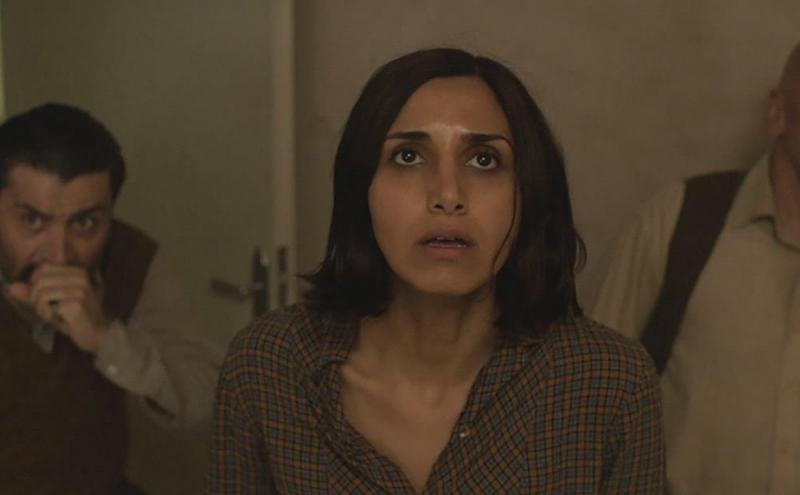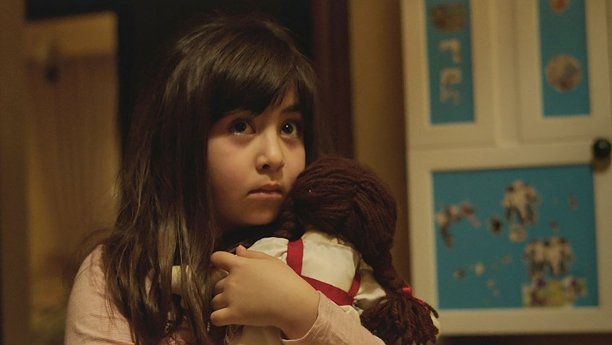Under the Shadow | reviews, news & interviews
Under the Shadow
Under the Shadow
Strikingly original terror stalks wartorn Tehran

We haven’t been here before. Tehran in 1980, bombed by its Iraqi invaders and jumpy with revolutionary fervour, is a place preoccupied with ordinary fear. Showing the normal if pressurised life he remembers from childhood in this demonised country is debutant writer-director Babak Anvari’s first coup. Letting this slide slowly into Persian myth and cinematic dread opens a new door in horror. The more arch A Girl Walks Home Alone At Night introduced the genre to the Iranian diaspora.
Shideh (Narges Rashidi) is struck her bitterest blow in the first scene. Her past in one of the left-wing groups that helped topple the Shah means – she’s coldly told by a male official – that her dream of being a doctor is over. As a professional woman, she has no future. This arbitrary edict can’t be answered, and Shideh’s life becomes one of suppression and fury. Her doctor husband, preoccupied with his posting away to the front line, is barely sympathetic. Her now illegal Jane Fonda aerobics VHS collection lets her manically work off some steam, and she does her best to maintain normal life for her beloved daughter, Dorsa (Avin Manshadi, pictured below).
 But when an unexploded missile lodges in a floor above her, the cracks in her ceiling help let in a more ancient nemesis: a desert djinn, which preys on fear, and can’t be escaped while it keeps a precious object. The lost doll Dorsa becomes increasingly obsessed by ties them to their war-emptied apartment block, and the shadow-thing lurking in it.
But when an unexploded missile lodges in a floor above her, the cracks in her ceiling help let in a more ancient nemesis: a desert djinn, which preys on fear, and can’t be escaped while it keeps a precious object. The lost doll Dorsa becomes increasingly obsessed by ties them to their war-emptied apartment block, and the shadow-thing lurking in it.
Rashidi, who shares her director’s memories of wartime fear (so similar to my mother’s of the Blitz), makes Shideh a memorable heroine. Physically and mentally durable, headstrong, flawed and unreasonable in the face of her society’s unreasonable pressure, suggestions that she’s an unfit mother keep her at her post with Dorsa too long. Like The Babadook, this is a domestic horror film about a mother and child’s lonely, steely bond.
MR James once wrote a ghost story about a sheet blowing on a line, and the djinn, too, manifests as a sheet, a cloak, a duvet and, most pointedly, the sort of chador Shideh forgets to grab as she flees it into the arms of a street patrol, and narrow escape from the lash. The doctor’s borders have become a housewife’s, her nightmares a potential widow’s. She turns over in bed to the shadowy body of a husband who isn’t there, and futilely tapes her window against the outside, where the wind gusts as if this is the old desert, with no protection to be had. A clawing fight with perhaps possessed Dorsa is the closest Under the Shadow comes to The Babadook’s guilty admission that love for a child can sometimes turn to hate. Its mixture of detailed realism and supernatural dread shows all the ways a society can drag a woman to hell.
Overleaf: watch the trailer for Under the Shadow
The future of Arts Journalism
You can stop theartsdesk.com closing!
We urgently need financing to survive. Our fundraising drive has thus far raised £49,000 but we need to reach £100,000 or we will be forced to close. Please contribute here: https://gofund.me/c3f6033d
And if you can forward this information to anyone who might assist, we’d be grateful.

Subscribe to theartsdesk.com
Thank you for continuing to read our work on theartsdesk.com. For unlimited access to every article in its entirety, including our archive of more than 15,000 pieces, we're asking for £5 per month or £40 per year. We feel it's a very good deal, and hope you do too.
To take a subscription now simply click here.
And if you're looking for that extra gift for a friend or family member, why not treat them to a theartsdesk.com gift subscription?
more Film
 Steve review - educator in crisis
Cillian Murphy excels as a troubled headmaster working with delinquent boys
Steve review - educator in crisis
Cillian Murphy excels as a troubled headmaster working with delinquent boys
 Can I get a Witness? review - time to die before you get old
Ann Marie Fleming directs Sandra Oh in dystopian fantasy that fails to ignite
Can I get a Witness? review - time to die before you get old
Ann Marie Fleming directs Sandra Oh in dystopian fantasy that fails to ignite
 Happyend review - the kids are never alright
In this futuristic blackboard jungle everything is a bit too manicured
Happyend review - the kids are never alright
In this futuristic blackboard jungle everything is a bit too manicured
 Robert Redford (1936-2025)
The star was more admired within the screen trade than by the critics
Robert Redford (1936-2025)
The star was more admired within the screen trade than by the critics
 Blu-ray: The Sons of Great Bear
DEFA's first 'Red Western': a revisionist take on colonial expansion
Blu-ray: The Sons of Great Bear
DEFA's first 'Red Western': a revisionist take on colonial expansion
 Spinal Tap II: The End Continues review - comedy rock band fails to revive past glories
Belated satirical sequel runs out of gas
Spinal Tap II: The End Continues review - comedy rock band fails to revive past glories
Belated satirical sequel runs out of gas
 Downton Abbey: The Grand Finale review - an attemptedly elegiac final chapter haunted by its past
Noel Coward is a welcome visitor to the insular world of the hit series
Downton Abbey: The Grand Finale review - an attemptedly elegiac final chapter haunted by its past
Noel Coward is a welcome visitor to the insular world of the hit series
 Islands review - sunshine noir serves an ace
Sam Riley is the holiday resort tennis pro in over his head
Islands review - sunshine noir serves an ace
Sam Riley is the holiday resort tennis pro in over his head
 theartsdesk Q&A: actor Sam Riley on playing a washed-up loner in the thriller 'Islands'
The actor discusses his love of self-destructive characters and the problem with fame
theartsdesk Q&A: actor Sam Riley on playing a washed-up loner in the thriller 'Islands'
The actor discusses his love of self-destructive characters and the problem with fame
 Honey Don’t! review - film noir in the bright sun
A Coen brother with a blood-simple gumshoe caper
Honey Don’t! review - film noir in the bright sun
A Coen brother with a blood-simple gumshoe caper
 The Courageous review - Ophélia Kolb excels as a single mother on the edge
Jasmin Gordon's directorial debut features strong performances but leaves too much unexplained
The Courageous review - Ophélia Kolb excels as a single mother on the edge
Jasmin Gordon's directorial debut features strong performances but leaves too much unexplained

Add comment